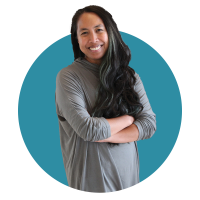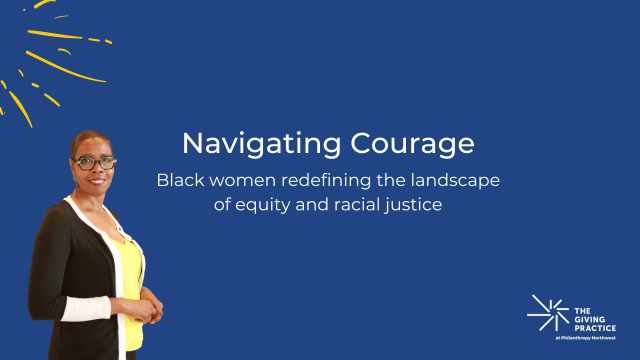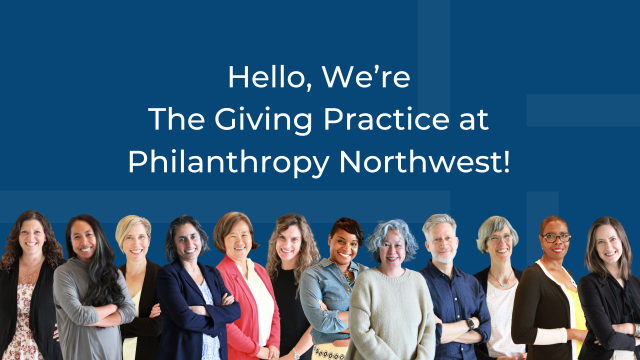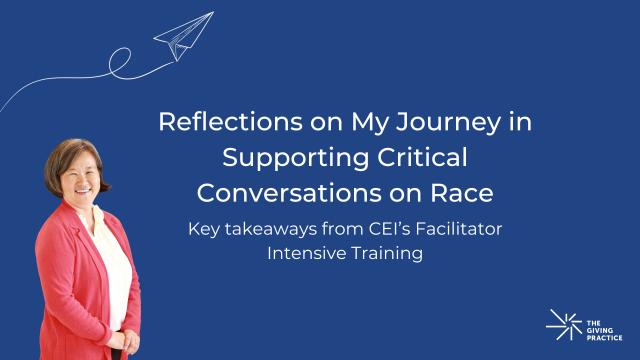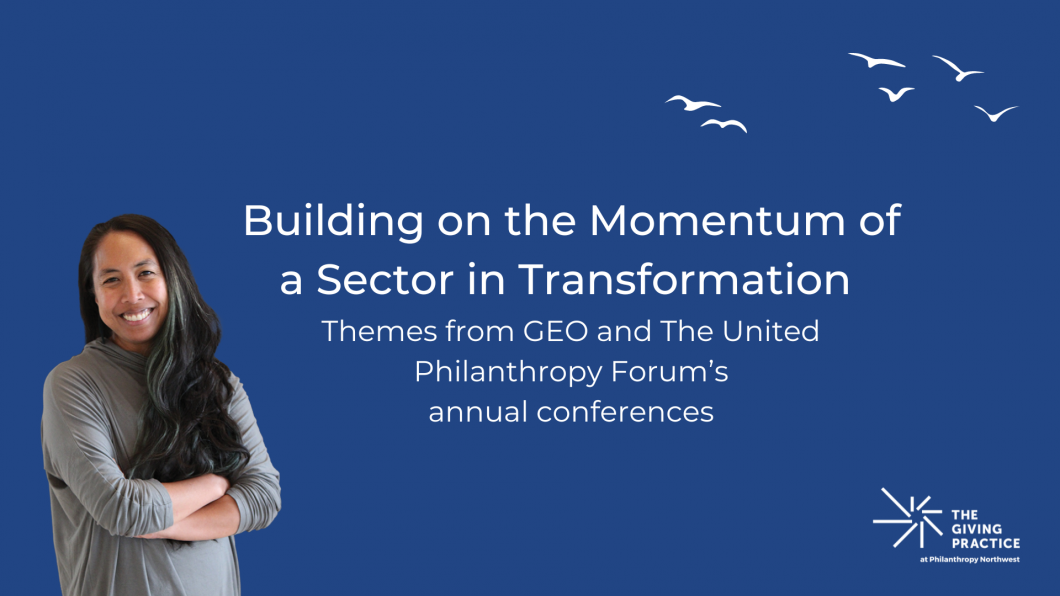
This past May, my fellow TGP Senior Advisor Lalitha Vaidyanathan and I were among the fortunate attendees of the Grantmakers for Effective Organizations’ (GEO) annual conference as both session facilitators and participants.
As we stepped into the main plenary room on the first day, I immediately felt a shift from the “look and feel” of GEO a decade ago to GEO today, which I believe is reflective of many of our field's conferences and gatherings. I observed many more Black and Brown bodies in the space. Programming was just as much about what we need to do internally – identity, listening, compassion, rest – as it was about what we need to do “out there” – in boardrooms, in our communities.
Two months later, this shift was again palpable and even made explicit at the United Philanthropy Forum’s (The Forum) annual conference in St. Louis. “Raise your hand if you would say that philanthropy is racist,” one speaker said. A sea of hands went up. “This wouldn’t have happened eight years ago. The system change is happening,” they proclaimed, drawing attention to the momentum of the sector amid the realities of increasing attacks on equity, justice and wellbeing of all communities.
Across powerful plenaries, breakout sessions and hallway conversations, GEO and The Forum’s conferences presented opportunities to tune in and commit to building on this momentum – to continue changing what philanthropy looks, sounds, and feels like and how it operates – in pursuit of meaningful and sustainable community impact.
Below are three themes that surfaced on the “how:”
1. Interrogate philanthropy's cultural source codes
Perhaps at the root of the “how” is our need to recognize culture – this intangible, often invisible thing – as one of the most critical levers for philanthropic transformation.
At The Forum’s conference, Héctor Sánchez-Flores, executive director of National Compadres Network, invited us to “try on” introducing ourselves to our neighbors not by our dominant tradition of names, organizations and titles, but in the tradition of his indigenous community - by the names of the people we belong to. In his case, his father and grandfather, in my case Flora Santos, Peping Bagasao and Isabel and Gaspar Sarmac.
The standard name-organization-title introduction is a simple yet powerful example of a cultural practice that may not always fully serve our goals in philanthropy, and particularly philanthropy in service of authentic connection and more equitable communities. The mis-alignment lies in the fact that philanthropy’s cultural source code – our dominant cultural practices and norms – comes from industries that have quite different intentions than philanthropy like banks, academia and business.
How can we make these inherited cultural norms more explicit and interrogate them further?
In a breakout session that I co-hosted alongside the Center for Community Action and Environmental Justice (CCAEJ), EMA Foundation and Marigold Fund we explored one place to start: examining philanthropy’s cultural practices and norms around three central pillars that drive banks, academia and businesses – assets, capacities and trust:
- Assets: In dominant practice, assets are assumed to be financial ($). At the EMA Foundation, assets go beyond the check. When getting to know one potential partner, for example, EMA found that this non-profit had invaluable assets including strong leaders, resilient communities, a clear vision and a team that was highly effective at empowering its community.
- How might we form a habit of viewing assets more holistically?
- Capacities: In philanthropy, the idea of “capacity-building” is generally applied to community-based organizations. In Marigold Fund’s work with CCAEJ, it is assumed that funders also have capacities to be built (i.e. learning and unlearning).
- What is your practice re: capacities in your system? What do you and others in your community need to thrive? What do you need to learn? Unlearn?
- Trust: “We start with building trust – and should we decide to partner together, we will bring our assets and capacities to bear in our work together,” EMA Foundation shared.
- Where does trust exist in your system? Where might it be cultivated? What might you need to learn? Unlearn?
2. Recognize and resource care and healing as critical levers for systems change
Across multiple sessions, we heard a need to recognize true community care – care that promotes community wellness, healing and liberation – as not just a soft thing lying alongside strategy, but the strategy itself. Because highly strategic, curated, designed and focused care is what all communities need to face any and all challenges, recover from them and heal to be ready for the next challenge.
And when we recognize that care for ourselves, our neighbors, our organizations and the communities where our philanthropies are active are inextricably interconnected, we see that care is a critical and significant lever for systems change that we must continue to invest in across all levels.
- Community care as a path to community healing was beautifully exemplified by the Essie Justice Group – Essie, for short – led by Gina Clayton-Johnson, a plenary speaker at GEO. Essie supports women with incarcerated loved ones. According to their research, 1 in 4 women in the United States have a loved one in prison, 1 in 2 Black women have a loved one in prison and women are the primary re-entry program for convicts. Furthermore, 86% of women suffer significant or extreme mental health impacts when a loved one is incarcerated, and 63% report significant or extreme physical health impacts.
Gina herself had someone she loved sentenced to twenty years in prison. When she asked her mother how her grandmother made it as a single mother with three jobs supporting three kids, her mother answered, “Baby, she had sisters.” It was community care – sisterhood – blood sisters and chosen sisters – to help out with money, child care, cleaning, feeding each other. And when Essie surveyed incarcerated individuals, they found that the reason most noted for staying alive in prison was again care – mom’s love or the love of women in their lives.
The community has what it needs. Essie’s approach is to acknowledge and support it through highly curated, research-driven programs.
- In a session on liberatory rest, Dana T. Weekes of Thrive Architects created a space for us to start with our own care and healing, and especially as our sector increasingly hires those more proximate to the myriad of challenges we seek to address. She invited us to reflect on the following questions: How do you rest? How many of those activities are “escape”? Are “restorative”? How many of those would you characterize as “liberatory”? If most of your answers are allowing you to “escape,” what are you fleeing? What makes an action “libertory” for you?
What I appreciated about this exercise was the space to think about what enables me to truly restore and feel free, liberated – and thus resilient enough to continue running the marathon relay race of combating poverty, climate change, the big systemic, root causes of the ills that impact our people and planet. And then to turn around and apply that concept to my philanthropic practice.
What more could I do – can we in philanthropy do – to support the communities we care about in feeling restorative, liberatory rest?
3. Continue prioritizing proximity to the communities we serve
In a plenary session at GEO’s conference, Dr. Robert Ross, who is retiring this year after 24 years as the CEO of the California Endowment, shared that when he first started in his job, grant applicants were seen as supplicants and the grant itself as transactional, but now as he leaves, he feels that through grants, grantmakers say to applicants, “I see you.”
This transformation is a result of philanthropy’s evolution to prioritize proximity to those we seek to support - through participatory practices, trust-based practices and most recently, the emergence and growth of intermediary funds that regrant to grassroots organizations.
- The New Breath Foundation, for example, is an intermediary fund focused on regranting to Asian-American grassroots organizations. The founder of the New Breath Foundation, Eddy Zheng, in his introduction at GEO, shared his lived experience of being incarcerated for over 20 years. He has since dedicated himself to serving the needs of other previously incarcerated Asian-Americans through the New Breath Foundation. As a result of his lived experience, Eddy is intimately familiar with grassroots activity in this area, and knows many of the grassroots organizations working in this area. This positions him well to regrant funds to these grassroots organizations. Eddy also explained how the New Breath Foundation, which aggregates funds from larger foundations, also undertakes the reporting responsibility back to these larger funders, thereby alleviating grassroots grantees of that burden.
- Similarly, The Pillars Fund, is a Muslim-led intermediary fund that regrants to Muslim-led grassroots organizations working on issues affecting Muslim-Americans. The W.K.Kellogg Foundation was mentioned as an example of a large Foundation that is supporting the Pillars Fund, and by extension, supporting grassroots Muslim-led organizations.
Attending GEO and The Forum’s conferences highlighted for me that some of the most powerful levers of change today – culture, care and proximity – are often the least perceptible. And though we may not always see it, we are in transformation, even in this very moment.
Subscribe to our newsletter to stay up to date on our latest reflections, insights, interviews and more.
